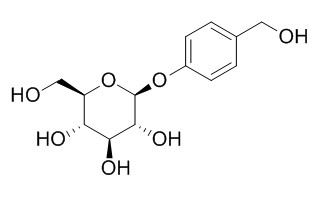Natural Products
Gastrodin
| Catalog No. | CFN99549 |  |
| CAS No. | 62499-27-8 | |
| Molecular Weight: | 286.28 | |
| Molecular Formula | C13H18O7 | |
| DBs | [PubChem]:274950604 [ChEMBL]:80828 [PCIDB]:29516 |
Standard InChI:
InChI=1S/C13H18O7/c14-5-7-1-3-8(4-2-7)19-13-12(18)11(17)10(16)9(6-15)20-13/h1-4,9-18H,5-6H2/t9-,10-,11+,12-,13-/m1/s1
Biological Activity
Gastrodin has anti-inflammatory activity, can significantly attenuate levels of neurotoxic proinflammatory mediators and proinflammatory cytokines by inhibition of the NF-κB signaling pathway and phosphorylation of MAPKs in LPS-stimulated microglial cells, suggests that gastrodin has a potential as an anti-inflammatory drug candidate in neurodegenerative diseases.[1]
Gastrodin protects midbrain of MPTP-intoxicated mice against oxidative stress, in part, through interrupting ERK1/2–Nrf2 pathway mechanism, which will give us an insight into the potential of gastrodin in terms of opening up new therapeutic avenues for PD.[2]
Gastrodin is one of the natural compound isolated from Gastrodia elata and has anticonvulsant effects, it may cause the elevation of GABA concentration by inhibiting the GABA shunt.[3]
Gastrodin activates PI3-K/Akt signaling and that inhibition of this pathway reverses the inhibitory effects of gastrodin on NF-κB and MAPKs activation in H9c2 cardiomyocytes.[4]
Gastrodin can inhibit allodynia and hyperalgesia in painful diabetic neuropathy rats by decreasing excitability of nociceptive primary sensory neurons.[5]
Gastrodin has protective effect to the prevention of neurotoxicity induced by ischemic stroke, the mechanism is by improving anti-oxidant and anti-inflammation activities, inhibiting apoptosis pathway, and increasing Akt phosphorylation and Nrf2 expression.[6]
Product
References
[1] Dai J N, Zong Y, Zhong L M, et al. Plos One, 2011, 6(7):e21891.
[2] Wang X L, Xing G H, Hong B, et al. Life Sci, 2014, 114(2):77-85.
[3] An S J, Park S K, Hwang I K, et al. J Neurosci Res, 2003, 71(4):534–43.
[4] Yang P, Han Y, Gui L, et al. Biochem Pharmacol, 2013, 85(8):1124-33.
[5] Sun W, Miao B, Wang X C, et al. Plos One, 2012, 7(6):e39647.
[6] Peng Z, Wang S, Chen G, et al. Neurochem Res, 2015, 40(4):661-73.
[7] Ju X H, Shi Y, Liu N, et al. J Chromatogr B , 2010, 878(22):1982-6.
Product Use Citation





